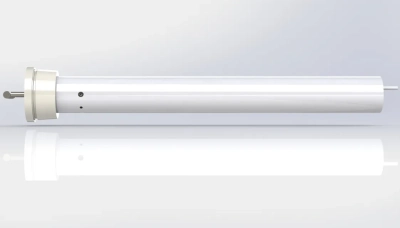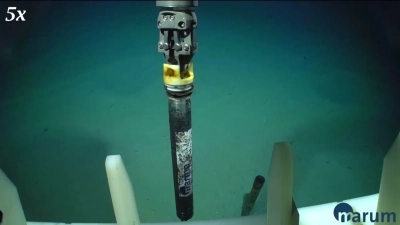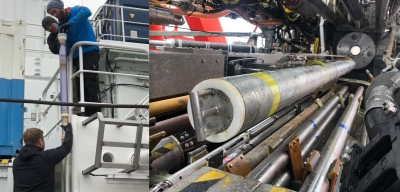- Home
- Our Methods
- Ocean Observatories
- Observatories
Observatories
MeBo borehole observatory
The MeBo borehole observatory (Type PTTi) consists of a tubular stainless-steel pressure housing (800mm in length, 76mm in diameter), a data logger, a power supply, and the installed sensors. The system is designed to operate for several years, depending on the logging frequency and additional sensor load, under a maximum pressure equivalent to 2000m water depth. The device is fastened to a drill string, ensuring undisturbed measurements while remaining retrievable by ROVs of nearly any size.


The observatory is standardly equipped to measure temperature, spatial orientation and differential pressure. The temperature sensor is a high-precision, long-term stable model from the IST company (Model TSIC 501F) with a measurement range of -10 to 60°C and an accuracy of ±0.1°C. The Keller PD-10E is used to detect relative pressure fluctuations within the borehole in relation to the water column. It is a high-precision pressure transmitter purchased from Keller, with a pressure range of 0-1 bar and an accuracy of 0.25% FS. A LIS3DH 3-axis acceleration sensor is utilized to monitor the spatial orientation and movement of the system, enabling detailed tracking of deployment, recovery, and potential borehole movement over time. Additionally, an external sensor can be connected to the observatory via an external port to expand the range of parameters. Power supply and data logging will be managed by the observatory. The data acquisition and power management are ensured by a 5 channel, low-power data logger (SCHWARTECH, Schwab Research Technology).
Fluid sampling
In order to be able to collect a geochemical time series, osmo-samplers were developed and deployed successfully in the past (Jannasch et al., 2003). They serve to assess any fluid flow or geochemical transients (e.g., Solomon et al., 2010). The osmo-samplers have two 2ML1 ALZET® membranes attached to the housing with two-part epoxy (Hysol ES1902). The ends of the distilled water and saturated salt (non-iodized table salt, NaCl) reservoirs are sealed with a single o-ring and held in place with a setscrew. This configuration will pump 73 ml/y at 20°C. The pump is attached to 300 m of small-bore Teflon tubing that holds 170 ml (1.19 mm I.D. and 2.0 mm O.D.). The tubing was filled with 10% HCl for 5 days before it was rinse with 18.2 M ohm water. Thus, this sampler can be deployed at 20°C for two years and maintain a continuous record for longer if the borehole temperature is cooler than 20°C

At the front end of the osmo-sampler, a unit is mounted that allows the “lower end” tubing string to descend into the open borehole using a spherical drop weight. The sphere is initially screwed to a threaded rod of 5 mm diameter when the MeBo is on deck or being deployed. After a pre-programmed period of 5 days, a timer is triggering a motor that unscrews the drop weight, which then carries the lower tubing (in our case set to 40-50 m length) into the basaltic aquifer at the ridge flank sites.
The whole unit is designed to screw into a custom-built MeBo drill rod, where it screws in with a POM conical thread sealed by an o-ring.

Fluid injection
The MeBo Tracer-T probe was developed in the Marine Geotechnics working group and basically contains two main parts. Below the handle for the ROV to manipulate the instrument later on (i.e. after deployment), there is a unit with a timer and motor that unscrews the lower plug of the second, lower part of the instrument.
For a flow experiment, the reservoir could be equipped with solutions of conservative tracers (sulphur hexafluoride, Xe, Kr, Ne, Ar, He, or fluorescent dyes) or reactive tracers such as cesium chloride, isotopically labelled C, esters, to name just a few. The reservoir also contains an MTL logger so that temperature can be recorded throughout.

Fluid sampling and injection release test carried out in the MARUM test pool.


